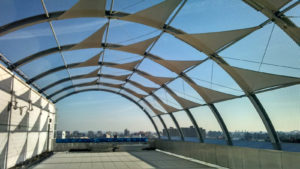By Sigrid Tornquist
Cities are pouring money into urban revitalization in an attempt to restore downtowns to their former vibrant glory, and many of those renewal designs are featuring shade structures, awnings and exterior shades, fused with the best of historic architecture. And in addition to providing shade and shelter from the elements, they also act as important and inviting aesthetic elements.

“Tension membrane structures like the ones we produce help to shape destination architecture in urban areas,” says Jacob Schwartz, owner of ITS (International Tension Structures), Phoenix, Ariz. “In fact, it is often the fabric architecture we provide that becomes the focus of that space and what draws people to the area.”
Schwartz advises letting the community and heart of the neighborhood inspire the structure and engineer it to stand the test of time. “The successful urban solutions, which utilize fabric architecture, do so with a long-term perspective and investment mindset,” he says.
“What is awesome about fabric for custom structures is the curvature and shapes that can be created by them,” says John Douds, vice president of southeastern sales for FabriTec Structures, Dallas, Texas. “During the day the structures allow natural light into the space, which is an energy money saver. At night you can backlight the structures so there’s a glow that comes off the fabric.”
But creating the right structure to draw people into an urban area all starts with asking the right questions and working with the architects on the design, he says. “Typically architects come to us and ask what we can do with a given space,” Douds says. “I reply with several questions of my own. What do you want the piece to accomplish? How much space should it span? And of course, what’s the budget? Then we work off of a few concepts from them, choose one and start fine tuning.”
Awnings have been around longer than tension membrane structures but continue to play a vital role in providing shade and aesthetics for urban renewal projects. “Landmark preservation has been happening in New York City for as long as I’ve been in the business, which is 30 years,” says Michael Catalano, president of Capitol Awning Co., Jamaica, N.Y. “Requirements in landmark districts are usually to have a retractable awning of some sort or at least an awning that looks retractable. What it usually comes down to is a shed style awning with open ends and a loose curtain on the front. In some cases a canopy,” he adds.
Although exterior shades have long been popular in Europe, they’re just now gaining momentum in the United States, and provide a sleek and energy-efficient solution to solar heat gain. “Exterior shades are a wonderful way of being very energy-efficient,” says Neil Gordon, president of InSync Solar, Chestnut Ridge, N.Y. “With an interior shade you can block 50 percent of solar heat gain but with an exterior shade you’re blocking 85 percent of heat gain from entering the space.”
Gordon points out that it’s not only the southern states with the most intense solar heat gain challenges that are embracing exterior shades. “That’s where we are getting the biggest response from people who need protection from the sun,” he says. “But we’re doing projects throughout the north, including in Manhattan, Chicago and just outside of Toronto.”
Sigrid Tornquist is a writer and editor based in St. Paul, Minn.
 TEXTILES.ORG
TEXTILES.ORG


